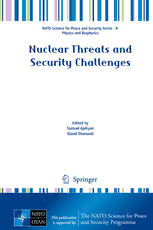
Nuclear Threats and Security Challenges PDF
Preview Nuclear Threats and Security Challenges
NATO Science for Peace and Security Series - B: Physics and Biophysics Nuclear Threats and Security Challenges Edited by Samuel Apikyan David Diamond AB 3 Nuclear Threats and Security Challenges NATO Science for Peace and Security Series This Series presents the results of scientific meetings supported under the NATO Programme:ScienceforPeaceandSecurity(SPS). The NATO SPS Programme supports meetings in the following Key Priority areas: (1) Defence Against Terrorism; (2) Countering other Threats to Security and (3) NATO, PartnerandMediterraneanDialogueCountryPriorities.Thetypesofmeetingsupported are generally “Advanced Study Institutes” and “Advanced Research Workshops”. The NATO SPS Series collects together the results of these meetings. The meetings are co-organized byscientistsfromNATOcountriesandscientistsfromNATO’s“Partner” or “MediterraneanDialogue”countries.Theobservationsandrecommendationsmadeatthe meetings,aswellasthecontentsofthevolumesintheSeries,reflectthoseofparticipants andcontributorsonly;theyshouldnotnecessarilyberegardedasreflectingNATOviews orpolicy. Advanced Study Institutes (ASI) are high-level tutorial courses to convey the latest developmentsinasubjecttoanadvanced-levelaudience Advanced Research Workshops (ARW) are expert meetings where an intense but informalexchange ofviewsatthefrontiersofasubjectaimsatidentifyingdirectionsfor futureaction Followingatransformationoftheprogrammein2006theSerieshasbeenre-namedand re-organised.Recentvolumesontopicsnotrelatedtosecurity,whichresultfrommeetings supportedundertheprogrammeearlier,maybefoundintheNATOScienceSeries. TheSeriesispublishedbyIOSPress,Amsterdam,andSpringer,Dordrecht,inconjunction withtheNATOEmergingSecurityChallengesDivision. Sub-Series A. ChemistryandBiology Springer B. PhysicsandBiophysics Springer C. EnvironmentalSecurity Springer D. InformationandCommunicationSecurity IOSPress E. HumanandSocietalDynamics IOSPress http://www.nato.int/science http://www.springer.com http://www.iospress.nl SeriesB:PhysicsandBiophysics Nuclear Threats and Security Challenges editedby Samuel Apikyan NationalCenterofSecurityandProtection,USA and David Diamond BrookhavenNationalLaboratory,USA 123 PublishedinCooperationwithNATOEmergingSecurityChallengesDivision ProceedingsoftheNATOAdvancedResearchWorkshopon PreparednessforNuclearandRadiologicalThreats LosAngeles,USA 18–20November2014 LibraryofCongressControlNumber:2015944112 ISBN978-94-017-9936-2(PB) ISBN978-94-017-9893-8(HB) ISBN978-94-017-9894-5(e-book) DOI10.1007/978-94-017-9894-5 PublishedbySpringer, P.O.Box17,3300AADordrecht,TheNetherlands. www.springer.com Printedonacid-freepaper AllRightsReserved ©SpringerScience+BusinessMediaDordrecht2015 Chapter14wascreatedwithinthecapacityofanUSgovernmentalemployment.US copyrightprotectiondoesnotapply. This work is subject to copyright. All rightsare reserved by the Publisher,whether thewholeor partof the materialisconcerned,specificallythe rightsof translation, reprinting,reuseofillustrations,recitation,broadcasting,reproductiononmicrofilms or inanyotherphysicalway,andtransmissionor informationstorageandretrieval, electronic adaptation, computer software, or by similar or dissimilar methodology now known or hereafter developed.Exempted from this legal reservation are brief excerpts in connection with reviews or scholarly analysis or material supplied specifically for the purpose of being entered and executed on a computer system, forexclusiveusebythepurchaserofthework.Duplicationofthispublicationorparts thereofispermittedonlyundertheprovisionsoftheCopyrightLawofthePublisher’s location,initscurrentversion,andpermissionforusemustalwaysbeobtainedfrom Springer.PermissionsforusemaybeobtainedthroughRightsLinkattheCopyright ClearanceCenter.ViolationsareliabletoprosecutionundertherespectiveCopyright Law. The use of general descriptive names, registered names, trademarks, service marks, etc. in this publication does not imply, even in the absence of a specific statement, that such names are exempt from the relevant protective laws and regulationsandthereforefreeforgeneraluse. Whiletheadviceandinformationinthisbookarebelievedtobetrueandaccurate at the date of publication, neither the authors nor the editors nor the publisher can accept any legal responsibilityfor any errors or omissions that may be made. The publisher makes no warranty, express or implied, with respect to the material containedherein. Preface The world faces no greater or more urgent danger than a terrorist attack with the intentofkilling,maiming,andtraumatizingalargepopulation.Internationalpeace andsecurityisthreatenedinparticularbytheproliferationofnuclearmaterialsand technologies that could lead to a nuclear or radiological attack. More nations are trying to acquire nuclear weapons,and black markets trade in nuclear secrets and materials.Terroristsaredeterminedtobuy,build,orstealanuclearweaponorusea radioactivesourceinaconventionalbomb. Organizations like al Qaeda and the so-called Islamic State have said that obtainingtheseweaponsandperpetratinganother“Hiroshima”aretheir“religious duty.”Organizationssuch as these have the will, the technicalknow-how,and the financialresourcestomakethesethreatsareality. Our strategyto combatthese threatsis multilayered,andeventsin recentyears haveshownthenecessitytocontinuallyreevaluatenationalpreparednessprograms. Throughout the world there are people working on the key issues related to this subjectsuchas: (cid:129) Preventing,avoiding,orstoppingthreats (cid:129) Protectingourcitizensandassetsagainstthegreatestthreatsandhazards (cid:129) Mitigatingthelossoflifeandpropertybylesseningtheimpactoffuturedisasters (cid:129) Respondingquicklytosavelives,protectpropertyandtheenvironment,andmeet basichumanneedsintheaftermathofacatastrophicincident (cid:129) Recoveringthroughtimelyrestorationandstrengtheningofinfrastructureandthe economy,aswellasthesocialfabricofcommunitiesaffectedbyacatastrophic incident The NATO Advanced Research Workshop on “Preparedness for Nuclear and Radiological Threats” was held in Los Angeles, on 18–20 November 2014 with supportfromtheNATOScienceforPeaceandSecurityProgramme.Thepurposeof the workshop was to contribute to the critical assessment of existing knowledge on this subject, to identify directions for future research and policies, and to promote close working relationships between scientists, engineers, and policy makers from different countries and with different professional experience. More v vi Preface than100representativesof18countriesparticipated.Theprogramwas builtupon the accomplishments of The Hague 2014 Nuclear Security Summit and previous NATO workshops such as “Countering Nuclear/Radiological Terrorism” (2005); “Prevention,DetectionandResponsetoNuclearandRadiologicalThreat”(2007); and “Threat Detection, Response and Consequence ManagementAssociated with NuclearandRadiologicalTerrorism”(2008). Thisbookcontainsapproximatelyhalfofthepaperspresentedattheworkshop. TheotherhalfofthepapersarefoundinthebookNuclearTerrorismandNational Preparedness. We hope it will be useful not only for the multinational scientific andtechnicalcommunitiesengagedincombatingnuclearandradiologicalterrorism but also for decision makers and for those working at governmental and policy levelswhoseactionsaffectthedirectionsthesciencetakesandhowthetechnology is incorporated into country-specific national systems for combating nuclear and radiologicalthreats. LosAngeles SamuelApikyan Upton DavidDiamond Contents PartI NuclearSecurityandNonproliferation 1 GAO: Two Decades Evaluating the Impact and Effectiveness of U.S. Nuclear and Radiological MaterialSecurityPrograms............................................... 3 DavidTrimble 2 NeutralizingRadicalizedThreatNetworks,Disrupting WMDIllicitTraffickersandTargetingCorruptFacilitators.......... 13 DavidM.Luna 3 ToPursue anIndependent NuclearDeterrentorNot? Japan’sandSouthKorea’sNuclearDecisionMakingModels........ 23 EmilyCuraSaundersandBryanL.Fearey 4 Overview of the CooperativeProjectsImplemented by the EuropeanCommissionJointResearchCentre intheNuclearSecurityAreaOutsideEurope........................... 45 PaoloPeerani,V.Berthou,W.Janssens,andK.Mayer 5 ProliferationResistanceandPhysicalProtection(PR&PP) EvaluationMethodologyandApplications.............................. 51 RobertA.Bari 6 NextGenerationNuclearSecurityPolicy:Education, Research,andExperience ................................................. 59 ErikaSuzuki, BethanyGoldblum, RobertBrown, StanleyPrussin,andMichaelNacht 7 TheManagementofRadioactiveWasteinFrance:What IstheThreat? ............................................................... 71 Jean-MichelBonifaceandGéraldOuzounian vii viii Contents PartII CombatingNuclearTerrorism 8 NATONuclearPolicy,theUkraineCrisis,andtheWalesSummit ... 85 JeffreyA.Larsen 9 RiskInformingSecurityattheUSNuclearRegulatory Commission ................................................................. 97 JosephD.Rivers 10 SCK(cid:129)CEN’S Activities in the Field of CBRN Risk Mitigation:PracticalContributionstoImprovingNuclear SecurityGovernance....................................................... 103 KlaasvanderMeer,CarlosRojasPalma,andJohanCamps 11 EUEffortsinManagingCBRNTerrorAttacks......................... 113 FriedrichSteinhausler 12 AHolisticApproachtoRadiologicalTerrorism......................... 123 NatividadCarpintero-Santamaria 13 The StrategicImpactofanIranianNuclearWeapons CapabilityonIsrael ........................................................ 135 NadavMorag 14 NuclearSecurityRegulationintheUnitedStates:An OverviewofU.S.NRCFunctionsandActivities........................ 147 JureKutlesa 15 CurrentActivitiesoftheEuropeanUnioninFighting CBRNTerrorismWorldwide.............................................. 157 JozefSabol, BedˇrichŠesták, LubomírPolívka, andKamilMroz 16 Will the Implementation of Small Modular ReactorsAffectOur Response Protocolsto Nuclear andRadiologicalThreats?................................................. 169 JamesTomVossandRobertGoldstein PartIII Advanced Technologies for Nuclear Safetyand Security 17 AdvancedConceptsin Multi-dimensional Radiation DetectionandImaging..................................................... 179 KaiVetter,DanChivers,andBrianQuiter 18 Dynamics of International Nuclear Safety: Post-Fukushima Developments in Regulatory OversightandFilteredVentTechnologyinSixNuclearCountries... 193 KathleenAraújo Contents ix 19 TheValueofStandardsforDetectionofRadioactiveMaterials ...... 207 LeticiaPibidaandAnneSallaska 20 NovelNuclearMeasurementsTechnologies forSafetyandSecurity..................................................... 217 MassimoMorichi, RogerAbou-Khalil, PhilippeDubart, andWilliamRuss 21 CosmicRayGeneratedChargedParticles forCargoInspection ....................................................... 229 MichaelSossong, GaryBlanpied, SankaranKumar, andSeanSimon PartIV NuclearandRadiologicalPreparedness 22 LawrenceLivermoreNationalLaboratory’sContribution toU.S.PreparednessforNuclearandRadiologicalThreats........... 247 BruceE.WarnerandKarenRath 23 The Emerging Threat Environment and the Impact onNuclearPreparedness .................................................. 257 VaylOxford 24 Cross-Border Cooperation:A Key Towards Better PreparednessforNuclearandRadiologicalThreats ................... 265 AnnaNalbandyan 25 Challenges in National Nuclear Threat Reduction Field-RegionalPuzzle ...................................................... 277 LiaChelidzeandGiorgiNabakhtiani
